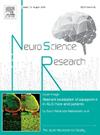Siponimod inhibits microglial inflammasome activation
IF 2.4
4区 医学
Q3 NEUROSCIENCES
引用次数: 0
Abstract
Siponimod is the first oral drug approved for active secondary progressive multiple sclerosis. It acts as a functional antagonist of sphingosine-1-phosphate (S1P) receptor 1 (S1P1) through S1P1 internalization, and also serves an agonist of S1P5; however, the detailed mechanisms of its therapeutic effects on glial cells have yet to be elucidated. In this study, we investigated the anti-inflammatory mechanism of siponimod in microglia. Pretreatment with either siponimod or the S1P1 antagonist W146 significantly suppressed the production of interleukin-1β in activated microglia stimulated with lipopolysaccharide plus nigericin, an inflammasome activator. Furthermore, siponimod treatment reduced the protein levels of cleaved caspase-1 and inhibited the formation of aggregates of apoptosis-associated speck-like protein containing a C-terminal caspase recruitment domain (ASC specks) in microglia. Our data indicate that siponimod achieves its anti-inflammatory effects by inhibiting inflammasome activation in microglia via S1P1 antagonism. This process is inferred to play a crucial role in mitigating the secondary progression of multiple sclerosis, where microglial activation in the gray matter is considered a key pathological factor.
西ponimod抑制小胶质炎性体活化。
西ponimod是首个被批准用于治疗活动性继发性进行性多发性硬化症的口服药物。它通过S1P1内化作为鞘氨醇-1-磷酸(S1P)受体1 (S1P1)的功能性拮抗剂,也可作为S1P5的激动剂;然而,其对神经胶质细胞的治疗作用的具体机制尚未阐明。本研究探讨了西泊尼莫德对小胶质细胞的抗炎作用机制。用西泊尼莫德或S1P1拮抗剂W146预处理可显著抑制脂多糖加尼古菌素(一种炎性体激活剂)刺激的活化小胶质细胞中白细胞介素-1β的产生。此外,siponimod处理降低了裂解caspase-1的蛋白水平,并抑制了小胶质细胞中含有c端caspase募集结构域(ASC specks)的凋亡相关斑点样蛋白聚集物的形成。我们的数据表明,siponimod通过S1P1拮抗作用抑制小胶质细胞炎症小体的激活,从而达到抗炎作用。据推测,这一过程在减轻多发性硬化症的继发性进展中起着至关重要的作用,其中灰质中的小胶质细胞激活被认为是一个关键的病理因素。
本文章由计算机程序翻译,如有差异,请以英文原文为准。
求助全文
约1分钟内获得全文
求助全文
来源期刊

Neuroscience Research
医学-神经科学
CiteScore
5.60
自引率
3.40%
发文量
136
审稿时长
28 days
期刊介绍:
The international journal publishing original full-length research articles, short communications, technical notes, and reviews on all aspects of neuroscience
Neuroscience Research is an international journal for high quality articles in all branches of neuroscience, from the molecular to the behavioral levels. The journal is published in collaboration with the Japan Neuroscience Society and is open to all contributors in the world.
 求助内容:
求助内容: 应助结果提醒方式:
应助结果提醒方式:


